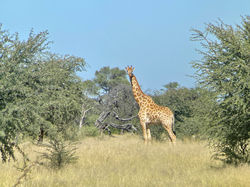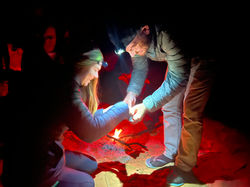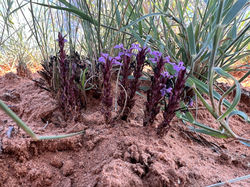
EXPEDITION WILD

Khamab Game Reserve, South Africa
The southern Kalahari desert
Expedition Basics:
8 Nights, 6 nights on foot.
Our Destination:
One of the largest private protected areas in South Africa is Khamab Game Reserve, 98 000ha of the southern Kalahari situated on the Botswana border in South Africa. Khamab is part of the greater Kalahari Desert that stretches far north into Botswana and west into Namibia. At its heart is the Central Kalahari Game Reserve, one of the largest protected areas in the world at 52 800 sq. km, south is Khamab Game Reserve and to the south west is the Kgalagadi Transfrontier Park, 37 256 sq. km and in the north is Makgadikgadi Pans and the Okavango Delta of Botswana making this landscape one of the largest protected landscapes in the world.
Day One:
Joburg to Molopo Game Reserve
We headed out northwest from Joburg on our 600km drive that took a good seven hours with the road getting smaller and smaller eventually becoming dirt for the last 80 km. You have the sense of leaving civilization as the farmland disappears and the Kalahari scrub starts to dominate with the odd salt pan dotted on the landscape. Molopo Game Reserve is a real breath of fresh air, a real hidden treasure in the northwest of South Africa on the Botswana border, teeming with wildlife! herds of wildebeest, eland, kudu, springbok….

 |  |  |
|---|---|---|
 |  |
Day Two:
After a chilly night we spent the morning getting our backpack ready for our next six-night adventure. We left Molopo Reserve heading eastwards to the entrance of Khamab Game Reserve where we were met by Wayne from Lowveld Trails. After all the formalities we headed out on foot to Kgetlwa Pan, a large grassy pan, where we set up camp right in the middle with stars from horizon to horizon. Our first night out was eventful with Bat-eared foxes, springbok springhares, and a porcupine but our most inquisitive visitor was a leopard that seemed captivated by this group of humans in its territory.
Day Three:
A cold, damp morning on the pan with heavy dew but the sound of lions in the distance made it all worthwhile. We waited till the sun was well up to burn off the dew then headed off. The landscape is generally flat, sandy with quite monotonous vegetation dominated by a few species of Acacia’s most notably the A. erioloba with their large conspicuous pods.
One of the less appealing creatures are the Tampans! a soft-shelled tick that frequents the sandy patches in the deep shade under the trees and can cause a nasty bite that can develop into a fever and can make some people quite sick. Studies have shown that they are attracted by carbon dioxide, literally your breath attracts them! No snoozing off under the shade in the midday sun.
On our walk we were fortunate to bump into a Bat eared Fox, then a Honey Badger! caught napping in a freshly dug hole, we also came across a large colony of ground squirrels, giraffe, wildebeest, and a lone red hartebeest.
Towards the end of the day and some 15kms later we caught up with the lions at one of the few waterholes in the area, Eland Pan. Two females and two subadult males that were later joined by two large males that woke us all up in a shot with their deep guttural call right next to our campsite, it felt like the ground was moving beneath us.
 |  |  |
|---|---|---|
 |  |  |
 |  |  |
 |  |  |
Day Four:
After being woken up by a bellowing male lion calling during the night, we broke camp and headed down to the small pan. Lots of activity could be seen from the night before, hyaena, massive lion tracks, black and white Rhino, and general game. We spent the morning under the shade of a Shepherds Tree, Boscia albitrunca, then retired to the shade of a few trees for the afternoon before heading out westwards along a few well-worn white rhino trails.
After a steady walk we came across a large previously burnt section of land that had seen a green flush, it became obvious why all the rhinos were coming back and forth from this area to Eland Pan about 5km. We eventually made camp in a large grassy open area, and were briefly visited by rhino.
Day Five:
Really nice slow start to the morning, packed up and headed further west, we were fortunate to come across three white rhinos resting up under the shade, we almost walked onto of them, but the sound of our footsteps must have alerted them, they stuck around briefly then ran off. Further to the west we came across a series of large open areas and we were greeted by a large herd of wildebeest resting up on the plains. It was now well into the hottest part of the day, so we found a nice lunch spot in a dried out pan with a clump of Ziziphus and B. albitrunca trees giving us the protection we needed from the baking sun. Later that day we returned to the open plains and set up camp on a sandy patch that ended up being a territorial male wildebeest patch, which he was quite perturbed about! Nevertheless, this campsite turned out to be one of the most spectacular settings, hosted by a spotted eagle owl, a community of bat eared foxes and springhares going about their business in the last light of the day.
Day Six:
We all woke up to see the magnificent sunrise and again a slow start to the morning waiting for the sun to warm the ground, the resident male wildebeest edged closer and closer to us seemingly growing impatient with our presence in his “patch”. We finally packed up and headed southwest through the large open areas. As the midday temperature rose, we found shelter under a small stand of trees and spent some time relaxing and taking in the environment. Towards the end of the afternoon, the clouds started building up and stretching out from the west making for a magnificent sunset before eventually covering the night sky, bringing a few drops of rain in the early evening.
 |  |  |
|---|---|---|
 |  |  |
 |  |  |
 |  |  |
Day Seven:
Night watch was very quiet but in the early hours of the morning we heard what sounded like two large male lions calling far in the northwest and continued to move closer to us over the course of the night.
We broke camp with the intention of heading out in the direction of the lions, but discovered a puff adder track that we followed and eventually found him coiled up in the cold morning air, right next to where we slept on the ground! Not to delay we headed off north easterly in the direction where we last heard the lions calling. After a few kms, we started growing weary thinking we had missed the tracks only to stumble right onto a lioness resting in the shade, surprised she quickly ran off. We did a loop and picked up her tracks getting another quick glimpse and after following up the tracks further we discover there were at least 3 lion tracks going in the same direction. We eventually decided to move off and give them their space only to bump into two white rhinos, it had turned out to be a busy morning. Late now in the day, we had to put our heads down and push through the heat to Marapoa Batho Pan. This pan is by far the largest pan, over 1,5km long and 0,5km wide. The pan was full of animals from gemsbok, wildebeest, springbok, warthogs which was a surprise.
Night watch was eventful with 4 white rhinos joining us around the campfire! and the continuous sounds of wildebeest and other animals gave the impression we were surrounded! The pans are a refuge for a lot of the animals at night with its short grass and clear open ground. During the early hours we had a curious spotted hyaena walk right up to our camp, only meters away from us!
 |  |  |
|---|---|---|
 |  |  |
 |
Day Eight:
We all woke up together to watch the sun rise on our last day taking in the cool and still morning air with the growing sounds of the waking day. We then slowly began to get our packs together, but before leaving this remote landscape we went on one final walk around as we watched herds of wildebeest, springbok, then zebra and lastly eland moving onto the pan, it was truly a great end to a magnificent week of trekking through this harsh but rewarding wilderness.
 |  |  |
|---|---|---|
 |  |  |